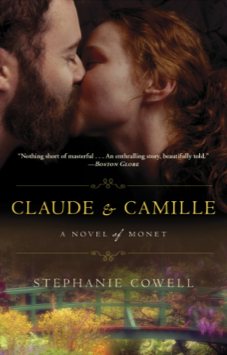Dear friends: NEW FEATURE TO MY BLOG! Interviews with the authors presenting at the New York chapter of the Historical Novel Society, March 26th at the Jefferson Market Library.
Welcome Stephanie, thank you so much for visiting my blog!
You have set your novels in the 16th, 17th, 18th, 19th and early 20th centuries with equal immediacy, with a palpable sensuousness. How do you create a natural scene that clues the reader into the time period?
When I become interested in a character, I immediately want to know what it was like to live in his daily visceral world. If an earlier century, how many candles could she afford to light her parlour and could she see someone coming in the door by them? I adore the particulars of daily life; I can’t remember where I read that in lower class Paris the restaurants had the utensils chained to the tables to prevent theft and put that in my Monet novel. When Mozart went into an aristocratic house, he would wear little heeled shoes and the women’s ornately arranged hair would smell of grease. I weave these little things in scenes so that the reader feels she is moving in that time.  I read and go to museums and research libraries. I try to imagine what each character would hear, smell, feel, see in every situation. I love to go to the places where people lived and am generally surprised how small they are. The Bronte’s home in Haworth for instance: they must have been bumping into each other on the stair. And the smell of drying laundry and baking bread was the background to Charlotte who was maybe fifteen feet away in the very small parlour, writing Jane Eyre above the barking of her sister’s large dog. The people I write about are mostly in the arts; they do not live in palaces.
I read and go to museums and research libraries. I try to imagine what each character would hear, smell, feel, see in every situation. I love to go to the places where people lived and am generally surprised how small they are. The Bronte’s home in Haworth for instance: they must have been bumping into each other on the stair. And the smell of drying laundry and baking bread was the background to Charlotte who was maybe fifteen feet away in the very small parlour, writing Jane Eyre above the barking of her sister’s large dog. The people I write about are mostly in the arts; they do not live in palaces.
What are you working on now?
Blanche and the Water Lilies, another novel about Claude Monet. Monet had a  stepdaughter who was also a gifted artist and in his later years, when he was over eighty and alone and trying to find the strength to create his huge water lily panels, she was the one who kept him going to the finish. She gave up love and her own work though he was not easy. There were lots of conflicts and difficulties. I wrote one Monet novel mostly set in his young struggling years but this is when he is old and living in Giverny. I spent a week in that town and walked its short length every day and of course I walked the house and gardens and asked myself, “What would it be like to live here? And have this difficult loving genius as your father calling your name?” Of course the novel is very difficult to do. I have to study so many things! But all books are difficult and historical novels are three times as difficult as anything else as everyone knows.
stepdaughter who was also a gifted artist and in his later years, when he was over eighty and alone and trying to find the strength to create his huge water lily panels, she was the one who kept him going to the finish. She gave up love and her own work though he was not easy. There were lots of conflicts and difficulties. I wrote one Monet novel mostly set in his young struggling years but this is when he is old and living in Giverny. I spent a week in that town and walked its short length every day and of course I walked the house and gardens and asked myself, “What would it be like to live here? And have this difficult loving genius as your father calling your name?” Of course the novel is very difficult to do. I have to study so many things! But all books are difficult and historical novels are three times as difficult as anything else as everyone knows.


Fascinating. Wonderful anecdotes really capture the essence of writing historical fiction. Great interview.
Hi Andrea, thanks for your comment! The book is extraordinary and I’ll look forward to seeing you at the event. -Loretta
I’m so excited to read this book! It’s on my TBR list!
The way she speaks about Haworth and the Brontes…lovely.
I find my own researching and writing process to be similar.
Drēma Drudge
-Author of Victorine, Manet’s favorite model turned painter